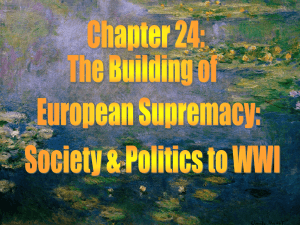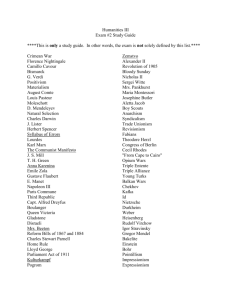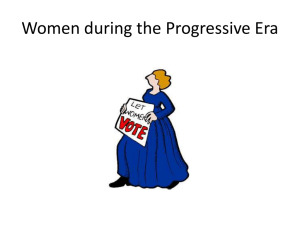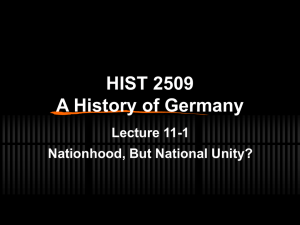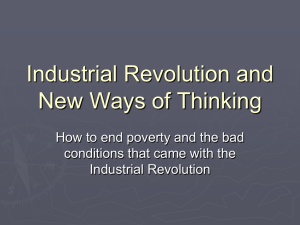Chapter 23 The Building of European Supremacy
advertisement
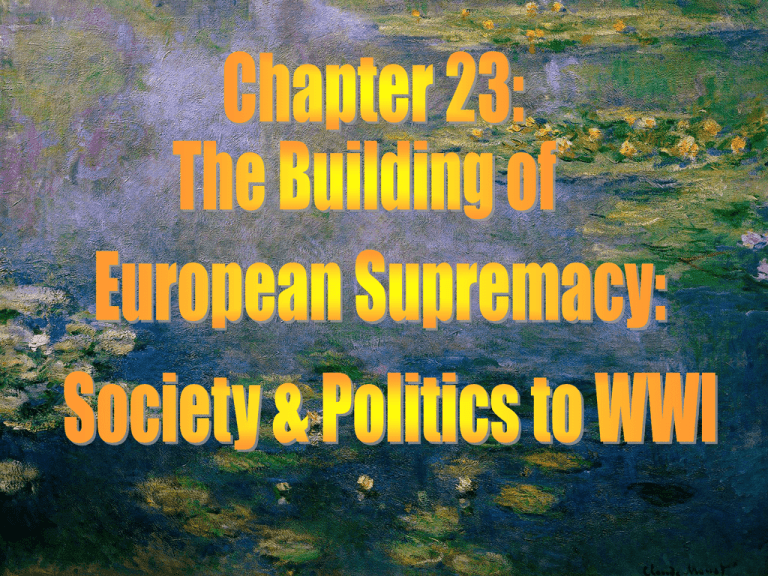
Chapter 23 Key Topics • KEY TOPICS • The transformation of European life by the Second Industrial Revolution • Urban sanitation, housing reform, and the redesign of cities • The condition of women in late nineteenthcentury Europe and the rise of political feminism • The emancipation of the Jews • The development of labor politics and socialism in Europe to the outbreak of World War I • Industrialization and political unrest in Russia Population Trends & Migration • population rises in Europe until 1910 when it levels off • population rates continue to rise in underdeveloped nations and areas leading to food shortages • people continued to move from rural to urban areas • between 1846 and 1932, 50 million Europeans leave their homeland to go to the United States, Canada, South Africa, Australia, Brazil and Argentina The 1870-1914 nd 2 Industrial Revolution • • new industries emerge in third quarter of 19th century leading to the Second Industrial Revolution • new industries included; steel, chemicals, electricity, and oil • Bessemer process – new way to mass produce steel cheaply revolutionizes the steel industry • Solway process – uses alkali production to make new soaps, dyes, and plastics • electricity changes how people live and travel • automobiles – Gottlieb Daimler – invents modern internal combustion engine leading to automobiles – Henry Ford – American, who through the assembly line made the auto accessible to the masses – autos lead to the growth of the oil industry The nd 2 Industrial Revolution • • • Development “zones” • Inner Zone Br, Fr, Ger, Belg, No. It, W. Austria • Outer Zone Ire., Iberian Pen., most of Italy, Europe east of Ger. • Underdeveloped Zone AfroAsia “Second” Industrial Revolution – Steam electricity – Internal combustion & diesel engines. – Cars, planes, submarines. – Britain “The World’s Industrial Workshop” – Corporations limited liability of investments. – Mass production. Free Trade-esp. Great Britain World Markets • bad weather and foreign competition make it tough for European industries in the last quarter of the century • stagnation, pockets of unemployment, bad working conditions, strikes and other forms of labor unrest emerge • expansion of industry and consumer demand bring Europe out of stagnation by late in the century The Middle Class in Ascendancy social distinctions of the middle class – owners and mangers – lived like an aristocracy – comfortable small entrepreneurs and professional people (teachers, librarians, shopkeepers) – incomes permitted private homes and large quantities of furniture, education and vacations – “white collar workers” – formed lower middle class – petite bourgeoisie – such as secretaries, retail clerks, lower level bureaucrats – spent money on consumer goods that made sure to make them look like middle class • tensions mount between the classes The Middle Class in Ascendancy Queen Victoria & Prince Albert admired the middle class & their fashion, social mores, & manners both emulated and drove what would be today considered ‘middle class.’ The Middle Class in Ascendancy A Typical Middle Class British parlor Late th 19 Century Urban Life The Redesign of Cities • The New Paris – Paris rebuilt for political purposes – to discourage riots and creation of thousands of government jobs – department stores, office Emperor Napoleon III complexes, apartments for the middle class, and a subway are built – arts and architecture – Paris Opera, Eiffel Tower, and Basilica of the Sacred Heart built – suburbs – to get away from the congestion of the city, many middle-class residents move to communities just Baron Haussman outside the urban centers Late th 19 Century Urban Life Paris 1890s Late 19th Century Urban Life London 1890s Late th 19 Century Urban Life Berlin 1890s Late 19th Century Urban Life Urban Sanitation • cholera – believed to be caused by filth and smell, touched all classes and reached epidemic proportions in 1830’s and 1840’s • water and sewer systems – disposed of human waste and provided clean drinking water • government involvement in public health – private property could be condemned if deemed unhealthy – new building regulations Varieties of Late Nineteenth-Century Women's Experiences Barriers for Women in Late 19th Century • property – until last quarter of century – most women in Europe could not own property – everything was in their husband’s name / only Britain changed this in 1882 with the Married Women’s Property Act • family law – divorce was difficult to obtain, men had legal control of the children, and contraception and abortion were illegal • education – could not attend universities until late 19th century – absence of secondary education for women – women with professional jobs were considered radicals and faced discrimination Varieties of Late Nineteenth-Century Women's Experiences • What was the status of European women in the 2nd half of the 19th century? • Why did they grow discontented with their lot? • What factors led to change? • To what extend had they improved their position by 1914? • What tactics did they use to effect change? • Was the emancipation of women inevitable? • How did women approach their situation differently from country to country? Women only gradually gained access to secondary and university education during the second half of the nineteenth century and the early twentieth century. Young women on their way to school, the subject of this 1880 English painting, would thus have been a new sight when it was painted. Sir George Clausen (RA) (1852–1944), “Schoolgirls, Haverstock Hill,” signed and dated 1880, oil on canvas, 20 × 30 in. (52 × 77.2 cm), Yale Center for British Art/Paul Mellon Collection, USA/Bridgeman Art Library (B1985.10.1). Courtesy of the Estate of Sir George Clausen The bicycle helped liberate women’s lives, but as this poster suggests, it also was associated with glamour and fashion. © Archivo Iconografico, S.A./CORBIS Varieties of Late Nineteenth-Century Women's Experiences New Employment for Women • new jobs – included secretaries, clerks, and shop assistants / still paid low wages • withdrawal from labor force – married women less and less in work force due to: – industries preferring unmarried women – men living longer – social expectations of the married women Women working in the London Central Telephone Exchange. The invention of the telephone opened new employment opportunities for women. Image Works/Mary Evans Picture Library Ltd. Varieties of Late Nineteenth-Century Women's Experiences Working-Class Women • putting-out system – manufacturer would purchase material then put it out to the tailors • subject to layoffs when demand for products slowed • had low wages and subject to exploitation Varieties of Late Nineteenth-Century Women's Experiences Prostitution • women displaced in an overcrowded work force turned to prostitution • most large 19th century cities had legal prostitution • usually low-skill workers with little education / "Albertine at the Police Doctor's Waiting Room", customers were painting by the Norwegian writer and working class men 1885-87 painter Christian Krohg illustrating his then very controversial novel about the life of a prostitute Varieties of Late Nineteenth-Century Women's Experiences Middle Class Women • domesticity – oversaw virtually all the domestic management and child care • religion – assured the religious instruction of their children and prayer was a major part of their daily lives • charity – worked with poor youth, poor young women, schools for infants, and societies for visiting the poor • sexuality – less sexual repression and due to contraceptives and the cost of having children, smaller families “Sweetness is to woman what sugar is to fruit. It is her first busines to be happy - a sunbeam in the house, making others happy. True, she will often have "a tear in her eye", but, like the bride of young Lochinvar, it must be accompanied with "a smile on her lips." Girls and women are willing enough to be agreeable to men if they do not happen to stand to them in the relation of father, brother, or husband; but it is not every woman who remembers that her raison d'être is to give out pleasure to all as a fire gives out heat.” Rev. E.J.Hardy, Manners Makyth Man, 1887 Department stores, such as Bon Marche in Paris, sold wide selections of consumer goods under one roof. These modern stores increased the economic pressure on small traditional merchants who specialized in selling only one kind of good. (See “Paris Department Stores Expand their Business,” page 766.) Image Works/Mary Evans Picture Library Ltd. Rise of Feminism • obstacles – many women did not support the feminist movement because – sensitivity to class and economic interests – cared more about national unity and patriotism – religious women uncomfortable with radical secularists • women’s suffrage in Britain – suffrage – the movement for women to vote – Millicent Fawcett – led the moderate National Union of Women’s Suffrage Societies – Emmeline Pankhurst – led more radical Women’s Social and Political Union, which encouraged strikes, arson, and vandalism – women given right to vote in Britain in 1918 • political feminism – women granted right to vote in France (after World War II) and Germany (1919) • Union of German Women’s Organizations – founded in 1894, supported suffrage, but more concerned about education, social, and political conditions Emmeline Pankhurst (1857–1928) was frequently arrested for forcibly advocating votes for British women. Hulton Archive Photos/Getty Images Inc. Jewish Emancipation Because many major financial institutions of nineteenthcentury Europe were owned by wealthy Jewish families, anti-Semitic political figures often blamed them for economic hard times. The most famous such family was the Rothschilds who controlled banks in several countries. The head of the London branch was Lionel Rothschild (1808–1879). He was elected to Parliament several times, but was not seated because he would not take the required Christian oath. After the requirement of that oath was abolished in 1858, he sat in Parliament from 1858 to 1874. Getty Images Inc.– Hulton Archive Photos Jewish Emancipation Jewish Citizenship • first half of 19th century, Jews in Western Europe began to gain equal citizenship • still many Jews could not own land and were subject to discriminatory taxes Russian Jews • government to the Jews – limited book publications – restricted areas where they could live – banned them from state service – excluded them from higher education • pogroms – organized riots against Jewish neighborhoods, supported by the government Jewish Emancipation The victims, mostly Jewish children, of a 1905 pogrom in Yekaterinoslav Source: http://en.wikipedia.org/wiki/Anti-Jewish_pogroms_in_the_Russian_Empire Labor, Socialism, & Politics to WWI Political Parties • universal male suffrage brings organized political parties • political parties with its workers, newspapers, offices, social life, and discipline mobilize new voters • socialist parties were divided on whether to accept social reform or start a revolution Labor, Socialism, & Politics to WWI The First International • British and French trade unionists form the First International, made up of socialists, anarchists and Polish nationalists • although short-lived, its updates on labor groups and conditions led to Marxism Karl Marx 1818-1883 becoming the most Author of: The important social strand Communist of socialism Manifesto & Das Kapital http://en.wikipedia.org/wiki/Karl_Marx Official Symbol of the Socialist International Great Britain: Fabianism & Early Welfare Programs • British socialism rejected Marxism- composed of Trade Unions and non-Marxist intellectuals. • Organized around Trade Unions-1892 Keir Hardie 1st ‘working man’ to be elected to Parliament. • Until 1901 labor & trade unions were allied with the Liberal Party in politics • Most influential group the Fabian Society favored change gradually, peacefully, and democratically. • Many early Fabians were famous British intellectuals: Beatrice & Sydney Webb George Bernard Shaw H.G. Wells MP Kier Hardie Tom & Virginia Woolf Bertrand Russell Emmeline Pankhurst Great Britain: Fabianism & Early Welfare Programs • Fabians did not favor the Marxist style total state of ownership of all means of production-rather favored more pragmatic collective ownership at the muncipal level-”gas & water socialism”-social democracy • 1901 Conservative dominated House of Lords vetoed legal protections for Trade Union. • In response the Trade Union Congress launched the Labour Party. • Labour Party was ‘arm’ were Trade Union workers, its’ ‘head’ was the Fabians. • 1906: Labor had 29 MPs. By the 1920s Labour had surpassed the Liberal Party as the main left-wing party in the UK & main opposiyon to the Conservatives. • 1924 Labor Party wins the general election & Ramsay MacDonald becomes the first Labour Prime Minister of UK. I won the election… …*sigh* I know… PM Ramsay MacDonald HRM King George V French Opportunism Rejected Jean Jaures Georges Sorel • opportunism – participation by socialists in the legislatures/cabinets of non-socialist governments • Opportunism rejected by the 2nd International & ordersFrench socialists to form one single party. • French workers often voted Socialist, but avoided political action • non-socialist labor unions with a tradition in anarchism looked to strikes as their main labor tactic-the general strike • Syndicalism: movement/and or economic system that strives to replace capitalism through action by the working class on the industrial front through labor unions as a potential means to overcome capitalism and administer society fairly. Germany: Social Democrats & Revisionism • Bismarck represses German Social Democratic Party (SPD) – anti-socialist laws passed by Reichstag actually strengthen the numbers of the SPD – passes programs such as accident insurance, disability & old age pensions as a conservative alternative to socialist policies • The Erfurt Program-1891 – supported Marxist ideas of the collapse of capitalism, but wanted to pursue goals through legislative action, not revolution-a hybrid between Marxism & British Fabianism • Revisionism – German socialists ideas of achieving humane social equality without having a revolution founded by Eduard Bernstein • critics of Revisionism felt that evolution towards socialism would not work in militaristic, authoritative Germany Eduard Bernstein Karl Kautsky August Bebel
